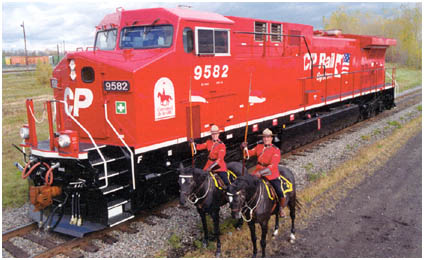|
Spring 2005

Canadian Pacific Railway Employee Communications
Room 500 401-9th Ave
S.W. Calgary AB T2P 4Z4
AC-Traction Becomes the New CPR
Standard
Steel Wheels
by Corporate Historian Jonathan Hanna

Around the same time CPR's first AC4400CW locomotive arrived on the scene,
in 1995, the company sponsored the RCMP Musical Ride.
In 1984, CPR kicked off the AC-traction revolution in
North America with a prototype locomotive. It took another eight years to test and ponder the new technology, but,
as a result, today CPR leads the pack, with the largest percentage of AC-traction locomotives of any
North American Class-1 railway.
Following the CPR's lead, the big locomotive manufacturers came out with production models. General Motors introduced
its 3,800-h.p., SD60MAC, in 1991, and the 4,000-h.p., SD70MAC, at the end of 1993. General
Electric introduced its 4,400-h.p. AC4400CW in 1994. By 1995, CPR was ready to make a decisive move.
By then the railway had the dubious distinction of operating the oldest locomotive fleet of all the
Class-1s on the continent - with an average age nudging 23 years. CPR hadn't bought any new motive power
since the problem-plagued SD40-F locomotives arrived on the scene. But, horrors of horrors,
the company, although formerly wedded to DC-traction, GM SD40-2 locomotives, went sideways.
Operations experts questioned the move away from tried-and-true GM to a builder it had only flirted with
in the early years of dieselization. But GE had a good product, ingrained total-quality production, and
a darn good purchasing plan.
So CPR went shopping for AC-traction locomotives at the GE store.
The first group of 40 GE AC-traction locomotives came with one free unit; and the second group came with
two extra - also, no charge. So, at the end of 1995, CPR had 83 AC-traction locomotives instead of just
the 80 it had ordered. Plus, with $12 million Canadian spare change, it took quick delivery of 10 rebuilt
SD40-2M DC-traction locomotives from Morrison-Knudsen.
But CPR didn't stop there. Firmly convinced of AC-traction benefits, the railway continued to buy
AC-traction locomotives from GE for the next nine years, and never looked back. The company dabbled in
GM's AC products, as well, but GE has been the mainline mainstay. CPR has gone through seven iterations of the AC4400
and is looking at the potential of the new environmentally friendly "Evolution Series" ES44AC locomotives.
Today, 42 percent of CPR's road locomotives are AC-traction, 582 of CPR's 1,386-unit fleet
of road locomotives are AC-traction, and most (85 percent) come from GE.
AC-traction locomotives deliver more tractive effort to the railhead than direct current
(DC-traction) locomotives. AC-traction motors also draw less of a parasitic load and need
less maintenance than DC-traction motors. Three 4,400-h.p., AC4400CW
AC-traction locomotives do the work of five 3,000-h.p., SD40-2
DC-traction locomotives.
| |
Vital Statistics
|
Numbers
|
8500-8580 8600-8655 9500-9683 9700-9784 9800-9840
CEFX 1001-1059
|
Class
|
DRF-44a
|
Builder
|
General Electric (GE)
|
Outshopped
|
1995-2004
|
Builder's Model
|
AC4400CW
|
Horsepower
|
4,400
|
Cylinders
|
16
|
Axles
|
6
|
Maximum speed
|
75 mph (120 kph)
|
Length
|
73 ft. 2 in. (22.3 m)
|
Width
|
10 ft. 3 in. (3.1 m)
|
Height
|
15 ft. 10 in. (4.8 m)
|
Weight
|
410,000-420,000 lbs. (185,975-190,500
kg)
|
Purchase price
|
$2.4 million approximately
|
This Momentum magazine article is copyright
2005 by Canadian Pacific Railway and is reprinted here with their permission. All photographs, logos, and trademarks
are the property of the Canadian Pacific Railway Company.
|